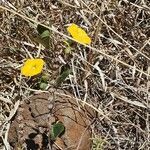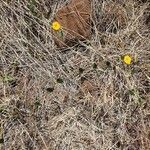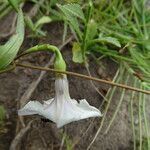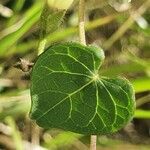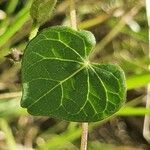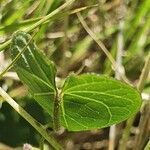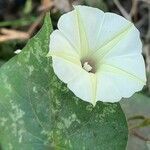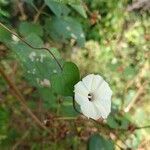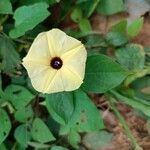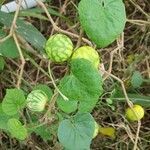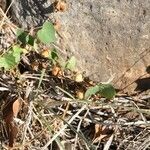Herbs twining; axial parts glabrous, spreading pubescent, or almost woolly. Stems thinly angular, 1-2 m. Petiole 1.5-3.5 cm; leaf blade cordate-circular or ovate, occasionally reniform, 2-8 X 1.6-8 cm, glabrous or sparsely pilose, base cordate, margin entire or minutely undulate, apex attenuate, acute. Inflorescences 1-3-flowered; peduncle almost filiform, 1.4-4 cm; bracts subulate, ca. 1.5 mm. Pedicel 0.8-2 cm, subglabrous, thickened and recurved in fruit distally. Sepals reflexed in fruit, elliptic-ovate, subequal, 4-5 mm, glabrous or ± pubescent, mucronulate, outer ones whitish margined. Corolla white or pale yellow, with darker midpetaline bands and a purple center, funnelform, 2-2.5 cm. Stamens included; filaments very unequal. Pistil included; ovary glabrous. Stigma 2-lobed. Capsule conical-ovoid or ± globose, 6-8 mm in diam., apiculate. Seeds black-brown, 4-5 mm, densely gray-brown tomentellous. 2n = 30.
Perennial herb; stems slender, prostrate or twining, up to 1.2 m. long, pilose or glabrescent.. Leaf-blade ovate (rarely linear-oblong), 2.7–9 cm. long, 0.4–7.5 cm. wide, acuminate or apiculate at the apex, cordate at the base, pubescent or glabrescent on both surfaces; petiole up to 8 cm. long.. Inflorescences 1–several-flowered; peduncle 3.5–4 cm. long; pedicels 1–2 cm. long.. Sepals ovate, ovate-orbicular or ovate-lanceolate, 4–8 mm. long, 1.7–4 mm. wide, acute or apiculate, glabrous to pilose.. Corolla yellow, orange, cream or white with purple, crimson or chocolate-brown centre, 1.4–2.3 (–2.5) cm. long.. Capsule globose, glabrous, 8–12 mm. in diameter, tipped with persistent style base.. Seeds ovoid, black, adpressed pubescent or velvety, up to 5.5 mm. long and 3.5 mm. wide (Fig. 24/1, p. 131.)
A climbing herb. It is a slender trailing plant. It lies along the ground. It can be a climber or twining. It has a taproot and can keep growing from year to year. The leaf stalks are 1.5 cm long. The leaf blades vary but are long and tapering to the tip with a broadly heart shape base. They are 4 cm long. The flowers occur singly or as a few together in the axils of leaves. The flowers are funnel shaped and 4 cm long and 3 cm across. They are pale yellow or white.
Leaf lamina ovate, rarely linear-oblong, 2·5–8·5 × 0·4–7 cm., acuminate or apiculate at the apex, cordate at the base, sometimes sagittate, entire or slightly undulate and often ciliate along the margin, pubescent or glabrescent on both surfaces; petiole up to 11 cm. long, pubescent or glabrescent as in the stems.
Inflorescences 1-several-flowered; peduncle slender, 1–8 cm. long, glabrous or shortly hairy; bracteoles minute, narrow, acute; pedicels 1–2 cm. long, sometimes minutely verrucose, shortly hairy or glabrous, at first erect but in fruit reflexed and thickened towards the apex.
Sepals subequal, oavte, ovate-orbicular, ovate-lanceolate or lanceolate, 4–8 mm. long, acute or apiculate, glabrous to pilose, in fruit all somewhat accrescent, ultimately often spreading or reflexed.
Corolla funnel-shaped, yellow, orange, cream or white, concolorous or with purple centre, 1 ·5–2·5 cm. long, glabrous or the midpetaline areas thinly hairy towards the apices.
In typical specimens the corolla is 1·4-2·5 cm. long, whitish-yellow with or without a purplish centre.
Stems several to many, slender, prostrate to twining, up to 3 m. long, pilose or glabrescent.
Perennial herb, with a taproot not thicker than a finger.
Seeds ovoid, black, appressed pubescent or velvety.
Capsule globose, tipped with persistent style base.
